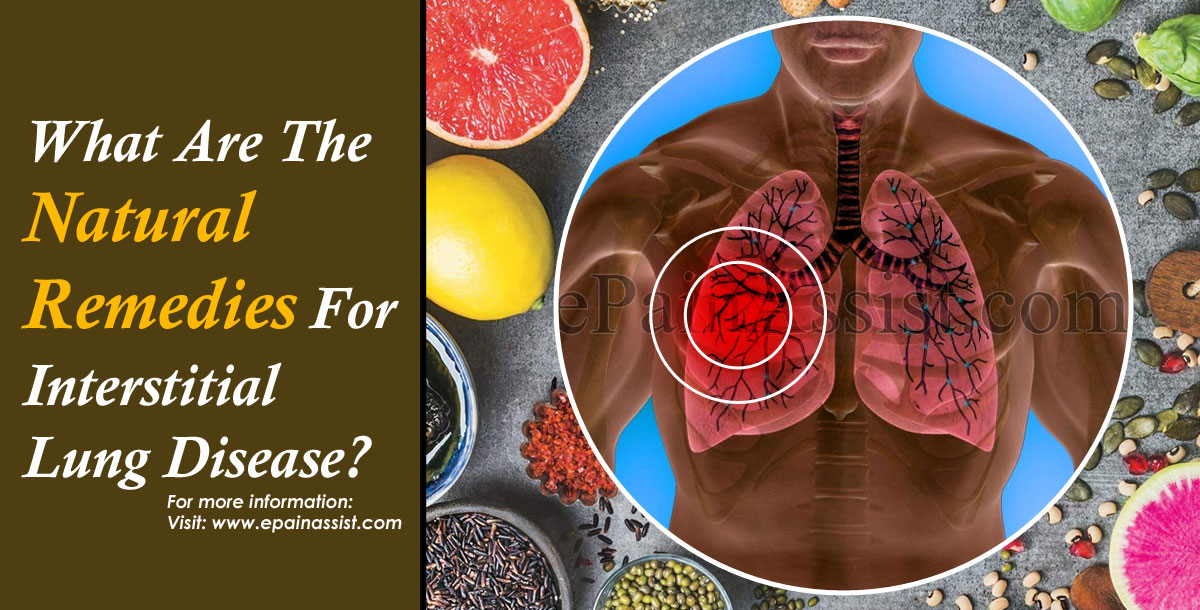ILD or interstitial lung disease is a group of diseases/disorders affecting the tissues and spaces around the air sacs (alveoli), which is known as the interstitium in the lungs. It includes more than 200 different chronic lung disorders that damage the interstitium. It is also known as interstitial pulmonary fibrosis.
Interstitial lung disease affects the lungs in three ways; firstly it destroys the lung tissue due to which the interstitium becomes inflamed and then finally fibrosis or scarring starts in the alveoli and interstitium making the lung stiff and breathing difficult for the affected person. This lung scarring that is caused is usually irreversible. However, with appropriate treatment the progression of the disease can be delayed. Most of the patients suffering from interstitial lung disease do not develop any alarming signs suddenly, but gradually as the disease progresses.

What Are The Natural Remedies For Interstitial Lung Disease?
Natural remedies of interstitial lung disease include maintaining a healthy lifestyle by incorporating a balanced diet, cessation of smoking and taking full coverage of vaccinations. A proper and healthy diet full of nutrients makes lungs clearer and relieves congestion, which in turn makes breathing easy. Quitting smoking increases the vital capacity of the lungs and hence better breathing. A full vaccination on time can prevent unwanted infections that might lead to respiratory insufficiency. A newer technique known as cellular therapy is also being used nowadays where analogous cells are used from the patient’s body itself. These cells are taken from the bone marrow or venous cells and they have the capacity to form many types of differentiated cells.
Interstitial lung disease is usually described as chronic, nonmalignant and noninfectious in nature. Although symptoms vary from person to person, but the basic terminology remains inflammation in the small airways of the lungs that will cause scarring in the lung tissue. Due to this scarring the lung tissue hardens and there is not enough expansion of the lungs while breathing, which leads to respiratory discomfort.
Some of the known causes that lead to interstitial lung disease are radiation exposure, connective tissue diseases such as scleroderma, sarcoidosis, genetic conditions and various pharmaceutical medications. It mostly affects adults in the age group of 40-70 years. Exposure to toxic agents such as asbestos, silica, metal, wood dusts and antigens can lead to interstitial lung disease.
The symptoms of interstitial lung disease are caused by abnormalities that characterize the disease into respiratory symptoms, symptoms caused by chest abnormalities, symptoms caused by changes in pulmonary function and those caused by microscopic patterns of inflammation and fibrosis. These symptoms include chest pains, difficulty in breathing or shortness of breath, dry chronic cough, lethargy, weakness, fatigue, tendency to tire easily even with moderate exercise, pain in muscle and joints, weight loss, clubbing of fingers and toes, edema in the lower legs, fluid buildup in the lungs (pulmonary edema), sleep apnea (difficulty in sleeping), headaches, fever and allergic reactions in some cases.
An advanced stage of interstitial disease will present with breathlessness, ongoing fatigue, rapid breathing and confusion due to increased levels of carbon dioxide in the blood.
Diagnosis And Prognosis of Interstitial Lung Disease
Interstitial lung disease is usually diagnosed by using a combination of blood tests, breathing tests, a chest X ray, a high resolution CT (HRTC) scan of your chest, and a stress test to determine the function of the lungs. In some cases a lung biopsy is also required when the ILD is confirmed by other tests.
Interstitial lung disease is mostly an incurable disease but with proper treatment we can delay the progression of the disease. The life expectancy of a person depends on the stage at which the person is diagnosed with it. If the lung biopsy shows predominance of fibrosis, it means the disease has reached an advanced stage which has lesser response to treatment. But in case of predominance of inflammation there is better response to treatment and the prognosis is better.
However, with certain lifestyle modifications and natural remedies one can limit the disease. Oxygen therapy, pulmonary rehabilitation and exercise, anti-inflammatory diet, natural pain relievers, and prevention of edema all go a long way in curtailing the advancement of the disease.
Also Read:
- Interstitial Lung Disease: Causes, Symptoms, Treatment, Diagnosis, Life Expectancy, Prognosis
- What Are The Lifestyle Changes For Interstitial Lung Disease?
- Can Interstitial Lung Disease Be Treated?
- How Long Can You Live With Interstitial Lung Disease?
- Is Interstitial Lung Disease Cancer?
- Is Interstitial Lung Disease The Same As COPD?
- What Are The Types Of Interstitial Lung Disease?
